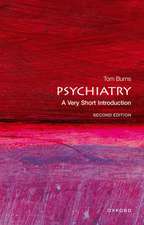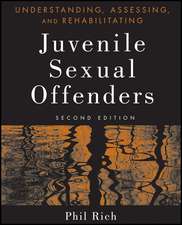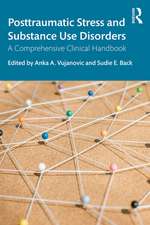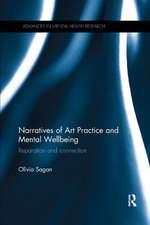Mood Disorders: Practical Issues in Diagnosis and Management
Autor Ather Muneeren Limba Engleză Paperback – 12 feb 2018
| Toate formatele și edițiile | Preț | Express |
|---|---|---|
| Paperback (1) | 490.62 lei 6-8 săpt. | |
| Taylor & Francis – 12 feb 2018 | 490.62 lei 6-8 săpt. | |
| Hardback (1) | 495.38 lei 6-8 săpt. | |
| Taylor & Francis – 12 feb 2018 | 495.38 lei 6-8 săpt. |
Preț: 490.62 lei
Preț vechi: 516.44 lei
-5% Nou
Puncte Express: 736
Preț estimativ în valută:
93.88€ • 98.22$ • 77.99£
93.88€ • 98.22$ • 77.99£
Carte tipărită la comandă
Livrare economică 02-16 aprilie
Preluare comenzi: 021 569.72.76
Specificații
ISBN-13: 9781138554504
ISBN-10: 1138554502
Pagini: 222
Ilustrații: 35 Halftones, black and white; 9 Tables, black and white
Dimensiuni: 152 x 229 x 12 mm
Greutate: 0.32 kg
Ediția:1
Editura: Taylor & Francis
Colecția Routledge
Locul publicării:Oxford, United Kingdom
ISBN-10: 1138554502
Pagini: 222
Ilustrații: 35 Halftones, black and white; 9 Tables, black and white
Dimensiuni: 152 x 229 x 12 mm
Greutate: 0.32 kg
Ediția:1
Editura: Taylor & Francis
Colecția Routledge
Locul publicării:Oxford, United Kingdom
Public țintă
Professional and Professional Practice & DevelopmentCuprins
Table of Contents
Chapter 1: Major Depressive Disorder and Bipolar Disorder
Introduction
Signs and Symptoms
Diagnosis of Mood Disorders
Major Depressive Disorder
Bipolar Disorder
Seasonal Affective Disorder (SAD)
Conclusion
Chapter 2: Major Mood Disorders: Differentiating Features
Introduction
Allostatic Load Model of Mood Disorders
Mood Disorders as Systemic Ailments
Differentiating Features of Unipolar and Bipolar Depression
Affective Ailments as Spectrum Disorders
Psychometric Scales
How to Differentiate Between Unipolar and Bipolar Depression?
Catatonic Symptoms of Mood Disorders
Conclusion
Chapter 3: Cormorbidity in Mood Disorders
Introduction
The Relation Between Mood Disorders and Inflammatory Comorbidity
Mechanisms Linking Immune-Inflammatory Imbalance to GMC in Mood Disorders
Therapeutic Considerations
Conclusion
Chapter 4: Etiology- The Role of Epigenetics
Introduction
The Relationship Between Mood Disorders and Inflammation
The Biological Mechanisms Linking Mood Disorders and Inflammation
Neuronal Plasticity
Childhood Abuse and Mood Disorders
The Link Between Childhood Trauma and Inflammation
Childhood Trauma and Neuronal Plasticity
The Epigenetic Link
Future Directions
Conclusion
Chapter 5: Neurobiology of Mood Disorders- The Circadian Connection
Introduction
Mood Disorders and the Circadian System
The Neurobiology of the Circadian System
Conclusion
Chapter 6: Pathogenesis of Mood Disorders- The Neuroinflammatory Hypothesis
Introduction
Neuroinflammation- The Role of Cytokines
Inflammation, Kynurenines and Mood Disorders
Purported Model of Depression
Oxidative Stress
Conclusion
Chapter 7: Mood Disorders- Staging and Neuroprogression
Introduction
Developmental Trajectory and Clinical Heterogeneity of Mood Disorders
Neuroprogression as the Basis for Staging Mood Disorders
Allostatic Load and Neuroprogression
Biomarkers of Mood Disorders
Staging Models of BD
Staging Model for MDD
Therapeutic Implications of Staging
Limitations of the Staging Models
Conclusion
Chapter 8: The Management of Treatment Resistant Depression- Monoamines and Beyond
Introduction
Switching or Combining 1st Line Antidepressants for TRD
Combining Atypical Antipsychotics with Standard Antidepressants
Voritoxetine in TRD
Targeting Other Pathways in TRD
Conclusion
Chapter 9: Treatment of Bipolar Depression- The Current Perspective
Introduction
Lithium and Anticonvulsants
Atypical Antipsychotics
Conclusion
Chapter 10: Manic Phase of Bipolar Disorder- Treatment Recommendations
Introduction
Diagnosis of Mania
Treatment of Mania
Maintenance Treatment
Conclusion
Chapter 11: Mood Disorders- Non-Pharmacological Treatments
Introduction
Psychoeducation
Cognitive Behavioral Therapy
Interpersonal and Social Rhythm Therapy
Dialectical Behavior Therapy
Mindfulness-Based Cognitive Therapy
Family Therapies
Future Directions in Research on Psychological Treatments
Conclusion
Chapter 1: Major Depressive Disorder and Bipolar Disorder
Introduction
Signs and Symptoms
Diagnosis of Mood Disorders
Major Depressive Disorder
Bipolar Disorder
Seasonal Affective Disorder (SAD)
Conclusion
Chapter 2: Major Mood Disorders: Differentiating Features
Introduction
Allostatic Load Model of Mood Disorders
Mood Disorders as Systemic Ailments
Differentiating Features of Unipolar and Bipolar Depression
Affective Ailments as Spectrum Disorders
Psychometric Scales
How to Differentiate Between Unipolar and Bipolar Depression?
Catatonic Symptoms of Mood Disorders
Conclusion
Chapter 3: Cormorbidity in Mood Disorders
Introduction
The Relation Between Mood Disorders and Inflammatory Comorbidity
Mechanisms Linking Immune-Inflammatory Imbalance to GMC in Mood Disorders
Therapeutic Considerations
Conclusion
Chapter 4: Etiology- The Role of Epigenetics
Introduction
The Relationship Between Mood Disorders and Inflammation
The Biological Mechanisms Linking Mood Disorders and Inflammation
Neuronal Plasticity
Childhood Abuse and Mood Disorders
The Link Between Childhood Trauma and Inflammation
Childhood Trauma and Neuronal Plasticity
The Epigenetic Link
Future Directions
Conclusion
Chapter 5: Neurobiology of Mood Disorders- The Circadian Connection
Introduction
Mood Disorders and the Circadian System
The Neurobiology of the Circadian System
Conclusion
Chapter 6: Pathogenesis of Mood Disorders- The Neuroinflammatory Hypothesis
Introduction
Neuroinflammation- The Role of Cytokines
Inflammation, Kynurenines and Mood Disorders
Purported Model of Depression
Oxidative Stress
Conclusion
Chapter 7: Mood Disorders- Staging and Neuroprogression
Introduction
Developmental Trajectory and Clinical Heterogeneity of Mood Disorders
Neuroprogression as the Basis for Staging Mood Disorders
Allostatic Load and Neuroprogression
Biomarkers of Mood Disorders
Staging Models of BD
Staging Model for MDD
Therapeutic Implications of Staging
Limitations of the Staging Models
Conclusion
Chapter 8: The Management of Treatment Resistant Depression- Monoamines and Beyond
Introduction
Switching or Combining 1st Line Antidepressants for TRD
Combining Atypical Antipsychotics with Standard Antidepressants
Voritoxetine in TRD
Targeting Other Pathways in TRD
Conclusion
Chapter 9: Treatment of Bipolar Depression- The Current Perspective
Introduction
Lithium and Anticonvulsants
Atypical Antipsychotics
Conclusion
Chapter 10: Manic Phase of Bipolar Disorder- Treatment Recommendations
Introduction
Diagnosis of Mania
Treatment of Mania
Maintenance Treatment
Conclusion
Chapter 11: Mood Disorders- Non-Pharmacological Treatments
Introduction
Psychoeducation
Cognitive Behavioral Therapy
Interpersonal and Social Rhythm Therapy
Dialectical Behavior Therapy
Mindfulness-Based Cognitive Therapy
Family Therapies
Future Directions in Research on Psychological Treatments
Conclusion
Notă biografică
Ather Munner, MD, is assistant professor of psychiatry at the Islamic International Medical College, Riphah International University, Islamabad. He has published papers in numerous journals, and is a member of the Pakistan Psychiatric Society and the European Psychiatric Association.
Descriere
This book covers diagnosis, differentiating features, and illness course and trajectories of principal mood disorders, namely major depressive disorder and bipolar disorder. The book provides essential information on mood disorders in a succinct and practical manner, while highlighting significant new findings in the area.
























